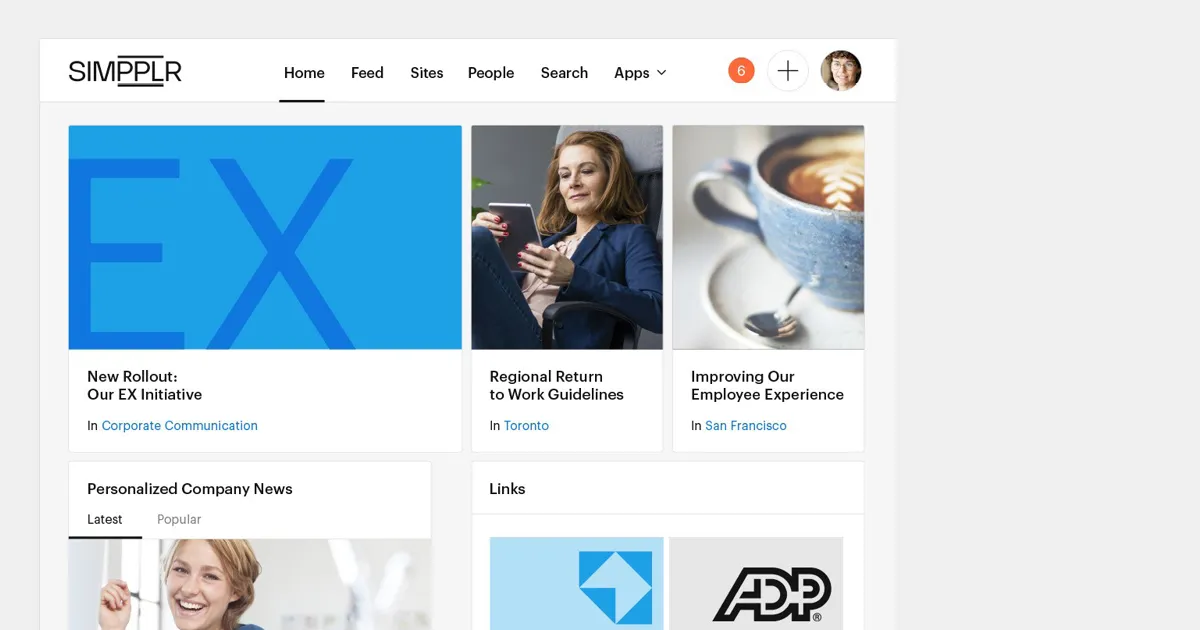Total cost of ownership (TCO) is a pivotal metric in evaluating the value of your intranet — and the direct and indirect costs of a stale intranet hurt more than your organization’s bottom line.
In the ever-changing landscape of business, where innovation and efficiency reign supreme, effective internal communications are essential for keeping your employees up to speed. But what if your company’s intranet now resembles a digital ghost town, with obsolete interfaces and static content haunting its virtual halls? It’s as if your intranet has been frozen in time, while the rest of your business races forward. That outdated intranet is costing your organization in myriad ways.
Today, agility and seamless connectivity are more critical than ever — and a fresh, dynamic and engaging intranet can propel your business by enhancing productivity, engagement and innovation.
A stale intranet, on the other hand, can hold your organization back. It impacts employee productivity, engagement and, ultimately, profitability. If you’re looking to improve TCO, it’s time to zoom in on your intranet investment.
Table of contents: How a stale intranet affects its TCO
- The intranet then and now: How intranets have evolved
- What is a stale intranet?
- Breakdown of intranet costs
- Total cost of ownership (TCO) explained
- How an updated intranet can lower TCO and improve ROI
Let’s get started!
Related: 2023 intranet Buyer’s Guide
The intranet then and now: How intranets have evolved
Intranet technology has evolved significantly over the years, transforming from basic internal communication platforms to sophisticated digital workplaces that play a crucial role in enhancing business productivity and opportunities. Here’s a high-level overview of how intranet technology has evolved and how outdated intranet systems can hinder business growth.
Early intranet systems (1990s-2000s): In the early days, intranets were simple and static websites that provided basic information to employees. They typically offered company news, policies and documents. These early intranets had limited interactivity and were primarily used for one-way communication.
Web 2.0 and social intranets (2000s-2010s): With the advent of Web 2.0 technologies, intranets evolved to incorporate more interactive features. Social intranets emerged, allowing employees to collaborate, share content, and communicate more effectively. Features such as forums, blogs, wikis and instant messaging improved communication and knowledge sharing.
Digital workplaces (2010s-Present): Intranet technology evolved into comprehensive digital workplaces that go beyond communication and collaboration. The modern intranet transcends static information repositories, offering interactive features such as real-time collaboration tools, social networking elements and multimedia integration. It fosters active engagement among employees and works to enhance knowledge-sharing across teams.
Modern intranets:
- Focus on the user experience (UX)
- prioritize integration and interoperability, seamlessly connecting with other business systems and software applications.
- support mobile access, ensuring that employees can stay connected and productive on the go.
- offer enhanced security measures, including robust authentication protocols and data encryption, safeguarding sensitive information from potential threats.
- are adaptable and scalable, capable of accommodating the evolving needs of the organization as it grows and evolves.
Unfortunately, many organizations let their intranets go stale and fail to incorporate many of the advanced features and functionalities that are now available through modern intranet software.
Related: Intranet examples for your digital workplace
What is a stale intranet?
A “stale intranet” refers to an internal network or website within an organization that has become outdated, unengaging and no longer effectively serves its intended purpose. Perhaps it hasn’t been updated with fresh content, modern features or user-friendly design elements — resulting in a lack of interest and diminished usability among its users.
It’s more common than you might think:
- A staggering 57% of employees surveyed see no purpose in their company’s intranet.
- One survey found that 47% of workers find their organization’s intranet difficult to use.
- A mere 58% of respondents in Gallagher’s 2023 State of the Sector report rated their intranet as effective — and respondents called out analytics, integration with the systems and social functionalities as the most ineffective aspects.
Simpplr research found that poor user experience, outdated content, lack of personalization and sub-par search functionality were among the 10 most significant reasons why intranets fail. A stale intranet also might lack interactive features and fail to provide the necessary tools/integrations for efficient collaboration and communication.
As a result, employees are less likely to use it — leading to decreased engagement, lower productivity, and missed opportunities for information sharing and teamwork.

Signs of an outdated internet
How do you know if your intranet is stale? Here are a few red flags to watch for:
- The content on the intranet is old, inaccurate or no longer relevant to the organization’s current activities or goals.
- Employees or members rarely visit the intranet because they don’t find the content useful or engaging. If you even have useful metrics, you find that only a small percentage of employees actively use the intranet, indicating a lack of interest and value.
- The internet’s user interface and design look outdated compared to modern websites and platforms. Technical issues, slow loading times and poor responsiveness are discouraging users from using it.
- The intranet lacks useful tools, features or integrations that would help employees perform their tasks more efficiently.
Now let’s dive into some of the challenges businesses with outdated intranets face.
Challenges of an outdated intranet
A stale intranet can have a range of detrimental effects on an organization’s progress and success — impacting employee engagement, productivity, processes, collaboration and trust.
Decreased employee engagement: For starters, an old-fashioned interface and navigation can make the intranet difficult to use and discourage employees from actively engaging with it. Lacking interactive features like discussion boards, surveys and social tools, it will likely fail to foster a sense of community and meet the expectations of today’s professionals.
Employees may become demotivated when they feel that the tools they are using are outdated and don’t reflect the organization’s commitment to progress.
Decreased productivity: This leads to lower productivity. What’s more, slow loading times and unresponsive interfaces lead to wasted time and frustration for employees trying to access information or perform tasks.
Hindrance to processes: A lack of modern features and integrations can also hinder employees’ ability to streamline workflows or find the information they need. Older intranet systems might not integrate well with other communication and collaboration tools, creating silos of information and hindering cross-functional collaboration.
Increased security concerns: Even more worrisome, outdated systems are more vulnerable to security breaches, potentially exposing sensitive company data.
Decreased trust: Employees might question the organization’s transparency and credibility. Especially with a large portion of U.S. employees continuing to work remotely, a stale intranet can make it difficult for organizations to meet the needs of their distributed workforce.
The bottom line: Outdated intranet systems can impede growth, prevent effective collaboration, and have a negative impact on business success.
Related: How a modern intranet UI design improves EX and CX
Breakdown of intranet costs
Direct and indirect costs associated with outdated intranet systems can be detrimental to an organization’s efficiency, productivity and overall business operations. Here’s an overview of both types of costs:
Direct costs of an outdated intranet
- Maintenance and support: Keeping an outdated intranet operational might require ongoing maintenance and technical support. As the system becomes more obsolete, finding experts to provide support can become more difficult and expensive.
- Security risks: Outdated intranets are more susceptible to security vulnerabilities and breaches, which can result in financial losses due to data breaches, legal penalties and damage to the organization’s reputation.
- Downtime and interruptions: Older systems are more prone to downtime, leading to disruptions in business operations. Employees might be unable to access critical information, collaborate effectively or perform their tasks — causing lost productivity and revenue.
- Limited features and functionality: Outdated intranet systems lack modern features and functionality that can enhance employee productivity and engagement. The organization might miss out on automation, collaboration tools and integrations that save time and money.
- Customization costs: If an outdated intranet needs to be customized or adapted to meet evolving business needs, the associated development and integration costs can be substantial.
Indirect costs of an outdated intranet
- Reduced productivity: Slow and inefficient intranet systems can lead to reduced employee productivity. Time spent waiting for pages to load, searching for information, or working around system limitations adds up over time.
- Employee frustration: Frustration and dissatisfaction among employees who struggle to use an outdated intranet can lead to lower morale and potentially higher turnover rates.
- Missed opportunities: Outdated systems can stunt knowledge sharing, resulting in missed opportunities to connect, learn from each other and innovate.
- Inefficient processes: Legacy intranet systems might not support modern workflow processes, leading to manual workarounds, duplicated efforts and costly inefficiencies.
- Training costs: Onboarding new employees or training existing ones on an outdated system can be more time-consuming and expensive, as they may need to learn workarounds and navigate a less intuitive interface.
- Lack of adaptability: As business needs change, an outdated intranet might not be adaptable enough to accommodate new requirements, leading to further limitations and additional costs.
- Inability to support remote work: The rise of remote and hybrid work arrangements requires intranet systems that can support seamless online collaboration and communication. Outdated systems might not provide the necessary tools for remote work, further impacting productivity challenges.
If direct and indirect costs get out of control, they can have a devastating impact on an organization’s bottom line.
Recognizing the costs associated with outdated intranets is essential for organizations to make informed decisions about whether to upgrade or replace their intranet systems to align with modern business requirements and ensure long-term success.
Total cost of ownership (TCO) explained
By combining direct and indirect costs, you can determine the total cost of ownership (TCO) of your intranet. Going beyond the initial purchase or implementation expenses, TCO considers ongoing costs such as licensing fees, hosting, maintenance, upgrades, support, training and potential customization.
TCO is a pivotal metric in evaluating the value of your intranet because it offers a comprehensive understanding of the financial impact of the system over its entire lifecycle.
By understanding the full range of costs involved, you can make more informed decisions about whether the benefits and capabilities of an upgraded intranet justify its costs.
TCO allows you to compare different intranet solutions objectively. A solution with a lower initial cost might have higher ongoing maintenance expenses, while a higher upfront investment might result in lower long-term costs.
Evaluating TCO helps you choose the option that aligns with your budget and strategic goals.
Why evaluate your intranet’s TCO?
An intranet is a long-term investment, and a TCO evaluation can help you plan for budget allocations over several years. This helps to ensure that you are prepared for ongoing expenses and any potential changes in technology or business needs.
Without a TCO analysis, you might overlook hidden costs that emerge during the system’s lifecycle — integration costs, data migration expenses, unforeseen support requirements or unexpected downtime, to name a few.
Low initial costs might mean the solution lacks the security, scalability or features needed for the growth of your organization, and a TCO evaluation can help you to anticipate future costs for ensuring your intranet can adapt to change and support your long-term business goals and objectives.
TCO is closely tied to return on investment (ROI). By comparing the costs with the expected benefits and efficiencies gained from the intranet, you can determine if the intranet solution delivers the desired value.

How an updated intranet can lower TCO and improve ROI
Instead of allowing your intranet to remain stale and continuing to lose money with a high TCO without any substantial return on your investment, consider upgrading to a modern intranet system.
While the initial investment in a modern intranet might seem high, the long-term cost savings can be well worth the investment.
Here are some reasons to consider upgrading your intranet:
Reduced maintenance costs: Modern intranet solutions are designed with up-to-date technologies and architecture, resulting in fewer technical issues and lower maintenance requirements. This reduces the need for ongoing troubleshooting and support, ultimately lowering maintenance costs.
Stronger security: Advanced security features and regular updates help to protect against cyber threats, lowering the risk of security breaches, potential data loss and associated costs of recovering from a security incident.
Improved user experience and workflows: User-friendly interfaces and intuitive navigation lead to faster adoption and reduced training costs. Employees spend less time learning how to use the system, resulting in higher productivity. Plus, integrated workflow automation and process optimization features help to streamline business processes — reducing the time and effort required for manual tasks and minimizing errors.
Enhanced collaboration: Modern intranet solutions provide efficient content management and organization, ensuring that employees can easily find the information they need. This reduces time spent searching for documents, emails or data and contributes to increased productivity.
Advanced collaboration tools such as instant messaging, video conferencing and real-time document editing within modern intranet solutions also foster seamless teamwork, resulting in faster decision-making.
And, since modern intranet solutions are designed with remote work in mind, they enable employees to collaborate effectively from anywhere.
Integrations and scalability: Modern intranet solutions often have robust integration capabilities, allowing seamless connections with other software and systems. Such integrations reduce manual data entry, data duplication and the costs associated with maintaining multiple disconnected systems.
Built to scale as an organization expands, a modern intranet can accommodate increased workloads without requiring significant upgrades or overhauls.
Real-time insights: Modern intranet solutions often offer analytics and reporting capabilities, providing insights into system usage, content effectiveness and user behavior. These insights will enable you to optimize your intranet and make data-driven decisions.
How Simpplr can help

By adopting modern intranet solutions, like Simpplr, organizations can create a more agile, efficient and cost-effective work environment that aligns with the demands of the digital age. As we’ve outlined in this post, these advanced platforms offer myriad benefits that drive organizational success without the high TCO often associated with older, outdated intranets.
Trusted by over 700 global brands, Simpplr is the most comprehensive intranet platform that delivers a seamless end-to-end employee experience — all in one unified platform. If you’re looking to improve intranet TCO, request a demo.
Dont forget to share this blog!

















